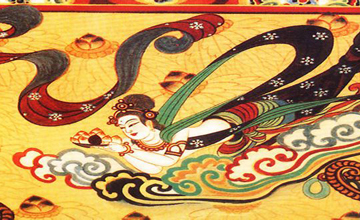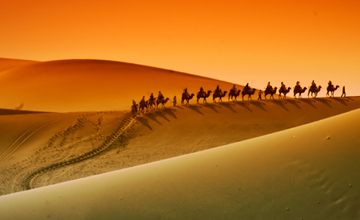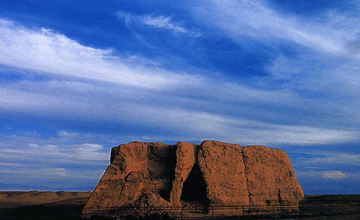The Introduction of Dunhuang
Situated near the common boundary of Gansu, Qinghai, and Xinjiang, long ago, historical city Dunhuang referred to as 'Sha Zhou' (beautiful desert oasis), the hub of middle and eastern silk road in ancient times. As the western cities of China, especially those in the desert, are known for their sandstorms, so tourists should protect themselves with glasses, hats and gauze kerchiefs, etc.
Recommended Dunhuang Attractions:
"Dunhuang," a city that boasts openness and respect to other cultures, preserves its ancient allure in the modern era, tourism has become an indispensable industry to Dunhuang City. Surrounding establishments include various classes of hotels and restaurants for your choosing.
So What to visit in Dunhuang has become a common question for the tour operators like us. Here we have mapped out some well-known scenery that any foreigners traveling to Dunhuang are worth visiting.
For history fans, Mogao Grottoes is the best spot to capture the treasure of ancient Buddhist temples and religious art in NW China.
Echoing Sand Mountain & Crescent Moon Spring is the famous tourist attraction in Dunhuang. You can climb the Mingsha Mountain, overlook the Crescent Spring, and enjoy the desert sunset on the top of the mountain, feeling the desolate vastness of the desert.
Jade Gate ( Yumen Pass), also known as Little Square Plate City, it was fortified by Emperor Wudi (156–87 BC) of the Western Han Dynasty (206 BC – 24 AD) and used as the gateway to the western regions on the ancient Silk Road.
Yardang Geopark is one of the major natural attractions in Dunhuang. It looks abrupt and strange on the endless Gobi Beach, especially at sunset. The wind-eroded mountains and rocks look like prehistoric monsters.
The Altitude and Geography of Dunhuang:
The average altitude of Dunhuang is 1139 meters; from Mt.Qilian in the south, Mt. Mazong in the north and desert from East to West, the landform of Dunhuang City is a declining basin-plain from West to the northeast, high in the north and south, and low in the middle.
Weather and Climate of Dunhuang:
Dunhuang has an arid continental climate, with dry and cold weather, and rare precipitation. It is dry and hot in summer, cold and long in winter, and the temperature is different between day and night. In winter and summer vary widely from 24.7 °C (76.5 °F) in July to −9.3 °C (15 °F) in January. Among them, from May to September is the best time to visit, so be sure to plan your trip during these months. Including Dunhuang City in your tour is a decision you won't regret.
Annual Temperature of the Year/℃ ( High-Low )
| Jan. | Feb. | Mar. | Apr. | May. | Jun. |
| -12/-22 | -10/-22 | -4/-17 | 15/1 | 19/7 | 25/12 |
| July | Aug. | Sept. | Oct. | Nov. | Dec. |
| 27/16 | 27/15 | 19/5 | 9/-2 | -1/-12 | -12/-21 |
History of Dunhuang:
In ancient times, Dunhuang was the center of trade between China and its western neighbors. At that time, it was the most westerly frontier military garrison in China. With the flourishing of business along the Silk Road, Dunhuang was prompted to become the most open area in international trade in Chinese history. It provided the only access westward for the Chinese Empire and eastward for western nationalities. The Buddhist gods, meditating in their sequestered shrines which peep out over the cliffs of Dunhuang, in what is known as Jiuquan City in northwest China's Gansu Province, have witnessed the desert change over a millennium. Although this pivotal oasis along the ancient Silk Road may appear a small sandpile without any unique characteristics, for the trading and cultural exchanges of the East and the West, this couldn't be further from the truth.Over 700 years ago, when Italian Marco Polo first visited Dunhuang, a city surrounded by a myriad of Buddhist caves, he was spellbound by the fusion of thriving international trade and vibrant culture. In his well-known book "The Travels of Marco Polo," the Venetian adventurer detailed the city as a global economic and cultural hub, for it created an unprecedented connection between the East and the West. Centuries later, following the reinvigoration of the ancient Silk Road into the new Belt and Road Initiative, Dunhuang has once again caught the world's attention.
How to Get to Dunhuang?
There are three ways to get to Dunhuang: Flight, Train, and Cars.1. Go to Dunhuang by Air:
The most convenient and economical way to travel to Dunhuang by air; Dunhuang Airport is located in Mogao Town, Dunhuang City, Gansu Province (12 kilometers east of the city). At present, regular airlines to Lanzhou, Xi'an, Beijing, Jiayuguan, and Urumqi are available at 38 flights each week.2. Go to Dunhuang by Train:
Of course, travelers can also choose to go to Dunhuang by train; the train fare is 300-500 CNY/pp include tax.Liuyuan Railway Station has direct connections to cities such as Shanghai, Beijing, Xi'an, Chengdu, Lanzhou, and Urumqi.
Dunhuang Railway Station - located ten kilometers away from the eastern part of the city, connecting Dunhuang city and Liugou stop, Guazhou County is 169 kilometers long.
Besides, with the access of the Lanzhou - Xinjiang High-Speed Rail to Dunhuang Railway in 2018, the Mogao Grottoes have been included in the national high-speed rail tourism network.
3. Drive to Dunhuang:
If we go to Dunhuang on a road trip instead of taking a flight, we will surely suffer a long journey, but it is also enjoyable. The highway from Jiayuguan to Dunhuang is 383 km. Because the Gobi Desert is endless and there are no obstacles, cars can travel at a speed of 100 km/t at high speed. Often in the course of walking, the horizon ahead will appear Lake water, tree shadow scenery. Half an hour or an hour later, the lake and the trees seemed to stop at the horizon forever and could not be approached. This was a mirage, a kind of illusion that appeared in the desert.Recommended Dunhuang Tours
* Dunhuang Turpan and Heavenly Lake Adventure * 5 Days Tour from Lanzhou to Dunhuang







